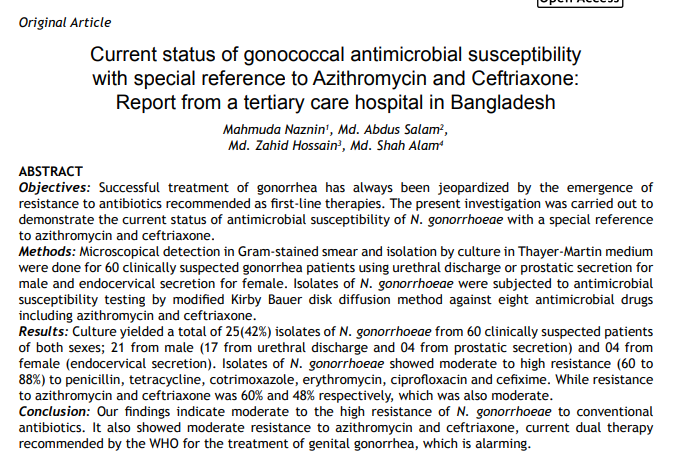Current status of gonococcal antimicrobial susceptibility with special reference to Azithromycin and Ceftriaxone: Report from a tertiary care hospital in Bangladesh
Successful treatment of gonorrhea has always been jeopardized by the emergence of resistance to antibiotics recommended as first-line therapies. The present investigation was carried out to demonstrate the current status of antimicrobial susceptibility of N. gonorrhoeae with a special reference to azithromycin and ceftriaxone. Microscopical detection in Gram-stained smear and isolation by culture in Thayer-Martin medium were done for 60 clinically suspected gonorrhea patients using urethral discharge or prostatic secretion for male and endocervical secretion for female. Isolates of N. gonorrhoeae were subjected to antimicrobial susceptibility testing by modified Kirby Bauer disk diffusion method against eight antimicrobial drugs including azithromycin and ceftriaxone. Culture yielded a total of 25(42%) isolates of N. gonorrhoeae from 60 clinically suspected patients of both sexes; 21 from male (17 from urethral discharge and 04 from prostatic secretion) and 04 from female (endocervical secretion). Isolates of N. gonorrhoeae showed moderate to high resistance (60 to 88%) to penicillin, tetracycline, cotrimoxazole, erythromycin, ciprofloxacin and cefixime. While resistance to azithromycin and ceftriaxone was 60% and 48% respectively, which was also moderate. Our findings indicate moderate to the high resistance of N. gonorrhoeae to conventional antibiotics. It also showed moderate resistance to azithromycin and ceftriaxone, current dual therapy recommended by the WHO for the treatment of genital gonorrhea, which is alarming.
Full text article available at:
https://www.ncbi.nlm.nih.gov/pmc/articles/PMC6290201/pdf/PJMS-34-1397.pdf


